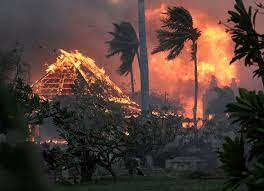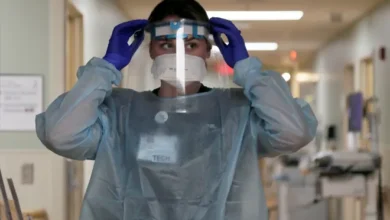Housing Crisis for Maui Wildfire Survivors as Tourists Return
After a wildfire burned his house and the town of Lahaina, Charles Nahale spent a sleepless night attempting to get some shut-eye in the back seat of his pickup truck. The next two nights weren’t any better: The singer and guitarist crouched in an abandoned hotel where he had entertained guests while resting his feet on one chair and sitting on another.
Nahale ultimately located a timeshare property with a kitchen, bed, and shower. He was allowed to stay there until Friday, when he once again had to transfer; this time, authorities put him up in a separate hotel condo.
He is just one of many individuals whose lives have changed after the worst American wildfire in more than a century claimed at least 99 lives. The fire burned tens of thousands of structures and uprooted inhabitants, who now face several difficulties due to Maui’s location and reputation as a tourist hotspot.
When you’re preoccupied with the necessities, it’s difficult to start the healing process, Nahale added.
Some people are moving from hotel to hotel, sometimes to make place for the visitors who are important to the local economy and are returning. With a housing crisis and high costs plaguing the island even before the fire destroyed an estimated 3,000 houses and apartments in Lahaina, many people are having difficulty finding someplace to rent.
Additionally, given Hawaii’s humidity and the difficulties in transporting mobile homes from the U.S. mainland, it is not practical for officials to bring in the houses that were utilized to house people following natural disasters elsewhere.
After the fire on August 8, the government, via the Federal Emergency Management Agency, paid for Nahale and around 8,000 other evacuated people to relocate into hotels, vacation homes, and other temporary accommodation. More than two months later, there are still around 6,900 individuals living in temporary housing.
It’s rare for FEMA to house so many people in hotels after a catastrophe, especially for months, but when visitors fled in the aftermath of the fire, Maui had a lot of vacant hotel rooms.
People in other states who are unable to return home after a catastrophe may move in with friends and relatives who are nearby and are a short drive away. That’s more difficult on Maui, a small island of roughly 150,000 inhabitants that’s located 30 minutes by aircraft from Honolulu, the closest large metropolis.
Hawaii’s FEMA area administrator, Bob Fenton, is in charge of overseeing the government’s response. He said that his organization had the power to place individuals in hotels for up to six months at a time. Nevertheless, he wants to see individuals find secure homes, “a place they could be for the next two Christmases,” Fenton said in an interview.
Nahale will be transferred to another condo with a kitchen owned by the Red Cross, whose caseworkers are in charge of managing FEMA’s hotel stay program, but it will only be accessible for 12 days. When thousands of other people are seeking for a long-term rental, it might be challenging, he added.
Gail McGovern, CEO of the Red Cross, said at a press conference on Wednesday that no one would be denied access to temporary accommodation while a long-term solution is found. Josh Green, the governor, asked anybody who feels like they are being forced out to speak with a Red Cross employee.
One of the fortunate people is Tiffany Teruya, who secured a two-bedroom apartment to live in with her 13-year-old son. The “tiny, tiny cottage” had a $3,000 monthly price tag, which was more than twice what she had been paying for their subsidized apartment in the Lahaina building that had burnt down.
On Wednesday, she signed a lease, using assistance funds and $2,000 from a relative to cover the first month’s rent and a security deposit. The next three months will be covered by Catholic Charities’ arrangements.
One of her extended family members resides at the cottage. She said that over 30 individuals, including families of three, four, and even six people, had seen the residence before her.
Teruya, who was a waiter at a restaurant on Lahaina’s renowned Front Street before the fire, stated, “These people are desperate too, you know what I’m saying?”
Matt Jachowski, a Maui-based software engineer, created a website to connect landlords with fire evacuees. More than 600 families have applied for accommodation on the site, but according to him, only few have been successful in finding housing since landlords are demanding more rent than the evacuees can afford.
According to his data, the average rent that evacuees are asking for is around two-thirds of market rate ($1,500 for a one-bedroom, $2,400 for a two-bedroom). According to Jachowski, some landlords demanded as much as $8,000 to $10,000 a month, claiming that visitors would pay that much.
FEMA has increased the rental aid it is providing to evacuees by 75% in an effort to assist. Residents of Lahaina who have been relocated may be entitled for up to over $3,000 for a one-bedroom. This may, at least temporarily, close the gap between tenants’ ability to pay and landlords’ demands, according to Fenton.
Long-term, Maui will need to construct more reasonably priced homes, according to Fenton, who noted that some proposals are awaiting zoning permission or need to be assessed for adequate water supplies.
FEMA is planning to construct up to 500 modular apartments utilizing prefabricated materials or 3D printing in case other interim options fall short. The organization has selected four locations close to sewage, water, and electricity infrastructure, three in Lahaina and one in central Maui. After the modular houses are taken down, the utility lines might be used for permanent housing after having to be extended to each individual lot.
Nahale described the situation with the shifting hotels as a “second wave of humanitarian disaster.” The kindest thing, he said, would be to allow individuals to celebrate the holidays in their current locations.
However, travelers are coming back and are starting to occupy some of the rooms. The island needs to welcome visitors back, according to Green and Maui Mayor Richard Bissen, to boost the economy and create employment. In September, Maui’s unemployment rate increased to 8.4% from 3.4% in the same month previous year.
Nahale finds solace in music as she endures the hardship. He showed two visiting journalists the one guitar he managed to grab before his house burnt before relocating to his new unit. Then he started playing a tune that his late buddy, the well-known Hawaiian musician Roland Cazimero, had composed.
Nahale sang, first in English and then in Hawaiian, “Please be careful/ Of the dangers of the world/ Careful not to be afraid/ Of the roads we’ve yet to go.”
He remarked, “That song simply sprang to mind. “That song can help heal.”







